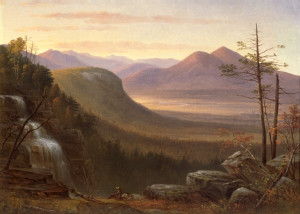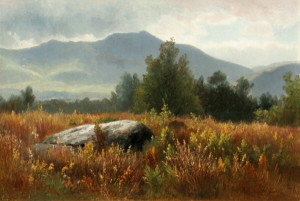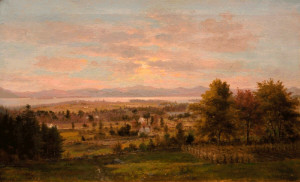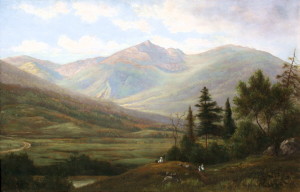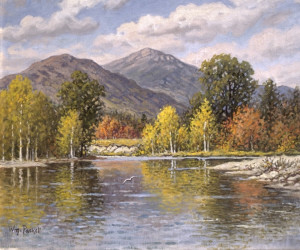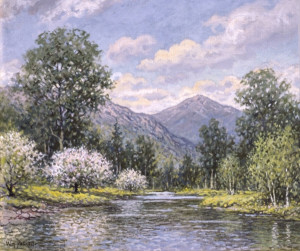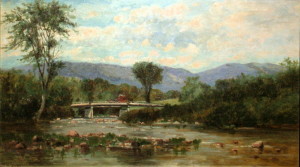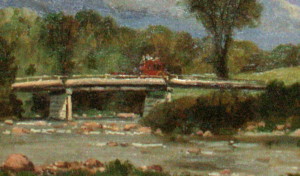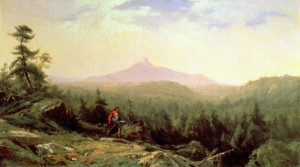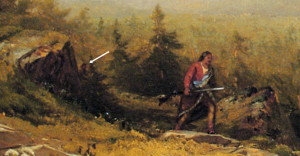Exhibition Dates
Art in Embassies, United States Embassy, Bishkek, Kyrgyz – August 2003 to August 2005
Jackson Historical Society, Jackson, NH – January 2006 to August 2006
Paintings are in order by artist last name. The artist name is a hyperlink to biographical information about the artist. The sizes given are canvas size followed by framed size. The provenance, if known, is given. Comments and general information about the painting are given last, followed by References (if any).
Benjamin Champney
Oil on canvas, 26 x 36 inches
Framed size: 33 ½ x 43 ½ inches
Unsigned
1855
Dr. Allan Handy Collection
This painting is illustrated in The Magazine Antiques, November, 1963 in the article Benjamin Champney and the American Barbizon, 1850 – 1857 on page 568. Its attribution is ‘Handy collection.’ It was called ‘Thompson’s Falls and the Saco Valley; 1855.’ The painting is clearly an early Champney and one of his best efforts.
Thompson Falls is described both in Champney’s and Starr King’s books. This location is not to be confused with the more popular Thompson Falls that is on Wildcat Mountain in Pinkham Notch. This location is, as Starr King describes, on a spur of Moat Mountain west of North Conway.
Champney describes the discovery of Thompson Falls in his book Sixty Years’ Art and Artists. “One day, Mr. Thompson, the landlord, said he knew that there was a waterfall behind the White Horse Ledge because he had heard its roar while he was in the logging camp in that neighborhood in winter. He gave us directions for finding it, fitted us out with a mountain wagon, loaned us his son William for a driver and guide. We drove through all the wood roads in vain, and were about to give up the search, when young Durand and myself determined to make a last effort, and after traveling through the dense woods for half a mile we found the stream, and following it down heard the rush of waters, and soon caught a glimpse of the chaotic masses of broken, ledgy rocks. We at once named it Thompson’s Falls, and, hastening back to our comrades, we gave them such glowing accounts of our discovery that we all wished to return the next day for sketching, and we did, and every day for a week William drove us over, and we painted the wild scene. It was, however, a hard place to find until we had blazed the trees, and cut away many impediments. It has remained to this day, a mysterious place, and many visitors have failed to find it after making a resolute attempt. ” (Sixty Years’, p. 105.)
Starr King has this to say about Thompson Falls. “One of the favorite excursions of those who remain long in North Conway is to the “Ledges,” Thompson’s Falls, and Echo Lake, on the other side of the Saco, the extreme distance being only some three miles. The Falls flow down a spur of the Mote Mountain, just in the rear of the lower Ledge. The loose rocks are thrown about in such complete confusion that it strikes the eye, fresh from the finished landscape around the meadows, as a patch of chaos too obstinate to be organized into the general Cosmos.” (The White Hills, pages 166-167.)
The ledge in the middle distance is Cathedral Ledge. Today there is an auto road to the summit of this ledge. The twin mountains in the distance are Bartlett (left) and Kearsarge (right). If you look closely, you can see a building on the top of Mount Kearsarge. Champney has depicted the first hotel that was built on the summit of Kearsarge. The hotel on Mount Kearsarge was built in 1845, expanded in 1868, and blew down in 1883 and was replaced by a shack. There is no trail to Thompson Falls today, so, just as Champney stated it remains “a mysterious place.”
References
Hennessy, William G. and Frederic A. Sharf. Benjamin Champney and the American Barbizon, 1850-1857. The Magazine Antiques, November, 1963, pages 568-569.
Benjamin Champney
Oil on canvas, 12 x 18 inches
Framed size: 17 x 23 inches
S/D/L/R: B. Champney 76
1876
Champney had a home and studio in North Conway just north of what is today the Red Jacket Inn. This building is still in North Conway. In the spring of 2004 we took a photo of Moat Mountain just across Route 16 from Champney’s home. The exactitude of the scene is striking in this Photo Comparison.
George F. Higgins
Oil on canvas, 24 x 40 inches
Framed size: 29 ¾x 45 ¾ inches
S/D/L/R: G F Higgins/1870
1870
This painting was purchased with the title Lake Winnipesaukee. But, is it really Lake Winnipesaukee? The high peak in the background might be Mount Washington. If the viewer is looking north, however, the sun could not be setting behind Washington. So … we believe that the painting is mistitled. From our excursions around the area, we believe that this view is looking west across Lake Wentworth from an area of east Wolfeboro known as Cotton Valley.
Sylvester Phelps Hodgdon
Oil on canvas, 16 x 25 inches
Framed size: 27 ½ x 36 inches
S/D/L/R: S. P. Hodgdon 1873
1873
This view is quite accessible today from the parking lot of the offices of the Mount Washington Carriage Road just north of Wildcat Mountain on the east side of Route 16. Hodgdon painted this scene almost exactly as it appears now. Compare this painting to a photograph taken in the spring of 2004. See Photo Comparison, and note that the Mount Washington Auto Road is shown in both at the lower left of the painting and photo.
William F. Paskell
Oil on canvas, 20 x 24 inches
Framed size: 25 ½ x 29 ½ inches
S/L/L: Wm. Paskell.
Circa 1930
Inscribed on verso, “Mount Kearsarge from North Conway, NH.”
William F. Paskell
Oil on canvas, 20 x 24 inches
Framed size: 25 ½ x 29 ½ inches
S/L/L: Wm. Paskell.
Circa 1930
Inscribed on verso, “Mount Kearsarge from North Conway, NH.”
Were these two paintings by Paskell meant to be a pair? They are both of the same subject, they are the exact same size, the age of the canvases appear similar, and both are inscribed verso with their subject. Paskell was a prolific painter and, therefore, he often did paint the same scene many times. But, it’s interesting to speculate that he meant these two paintings to be sold as a pair, or, perhaps there were four – one for each season.
The vantage point for these scenes is slightly different. Mount Kearsarge in Spring is from a further distance, obscuring the view of Bartlett Mountain which if to the left of Kearsarge in the fall painting.
Frank Henry Shapleigh
Oil on canvas, 10 x 18 inches
Framed size: 17 ¾ x 25 ¾ inches
S/L/L: F.H. Shapleigh
Shapleigh had a home and studio in Jackson, NH which he called Maple Knoll. The area surrounding Jackson provided him with many views for his paintings and is the reason he painted so many Jackson scenes.
This composition is very typical of Shapleigh. The sky in this painting is often called a “Shapleigh sky,” because, regardless of the details of the scene – whether it be New Hamsphire or Florida – he painted cottony clouds and used the same blue palette. He often painted water in the foreground and placed a bridge over the water in the middle distance. He would often color the distant mountains in purple, again serving as a characteristic of this artist. Somewhat unusual but none-the-less of special feature of this scene is the Concord Coach rumbling across the bridge over the Ellis River. See a detail of this element below. Note the boulders in the water. Shapleigh painted similar boulders in many of his scenes, always using the same brown palette.
Aaron Draper Shattuck
Oil on canvas, 10 x 18 inches
Framed size: 17 x 25 inches
S/D/L/L: A. D. Shattuck 58
1858
Possibly Charles Wood, New York
Jeanne C. & John J. Bowden, Bayside, Long Island, New York
Dr. and Mrs. Alick Osofsky, Hewlett Bay Park, New York
Collection of the Masco Corporation
This painting is signed on the back Wm. S. Mount, March 7th 1859 and inscribed “Figures introduced by particular request” on the reverse. See American Art Review, May-June 1976, pp. 71-72. The question to be asked is, was this a collaboration by the two artists, or did the new owner of the Shattuck scene know William Sidney Mount and make a request of him to add the figures? First note the “figures” is correct. Although one Indian is very prominent, there is a second one who is just visible behind the rock to the back of the first Indian. A detail of this area of the painting is shown below.
I believe the answer to the question posed is that this painting was a collaboration between Shattuck and Mount. Shattuck is known to have visited Jackson, NH every summer from 1854 to 1860. Also, in the year 1856 we know that Samuel Colman had a studio in Jackson that was shared by Shattuck, Daniel Huntington, Asher Durand, and William Sidney Mount! The fact that both artists were that closely acquinted is the reason that I believe they collaborated on this painting. Shattuck dates the painting 1858, but Mount did not introduce the Indians until 1859 as evidenced by his verso inscription.
This painting is illustrated in the Beacon Hill Fine Art publication titled McEntee & Company as Plate 15 (see References below).
References
Ferguson, Charles B. Aaron Draper Shattuck, White Mountain School Painter. American Art Review, May-June 1976, pages 68-81.
McEntee & Company. Exhibition catalog. Beacon Hill Fine Arts, November 25, 1997 to January 17, 1998.
